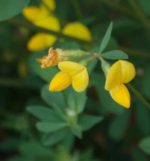 Also known as eggs and bacon and birdsfoot deervetch this herbaceous perennial is native to the grasslands of Eurasia and North Africa but has naturalized in the US and is considered an invasive weed in the Midwest where it forms dense mats that shade out the native vegetation. AIt is a member of the pea family, Fabaceae, that also includes beans, lupines, and mimosa. Plants grow up to 2′ tall from a long taproot with branched underground roots and above ground stolons and rhizomes. They have well-branched stems and alternate compound leaves with 3 leaftlets about .5″ long, the central 3 of which extend above the others giving rise to the trefoil part of the common name. From spring until mid summer, rounded clusters of 2-8 bright yellow to orange flowers appear. Each pea-like flower is up to 2/3″ long, has petals sometimes streaked with red, and resembles a slipper. The brown cylindrical seed pods are 1/4-1 3/4″ long, contain numerous seeds, and look like bird’s toes giving rise to the common name bird’s f00t trefoil/deervetch Like other members of the pea family, it fixes nitrogen in the soil and is highly nutritious to cattle without causing bloating. The flowers attract a large range of pollinators inclung bumble bees and butterflies making it a possible choice for a butterfly or wildlife garden. The genus name, Lotus, is from the Greek word lotos, a name given to a variety of plants including clover and fenugreek, and melilot. The specific epithet, corniculatus, is the diminutive from the Latin words cornus meaning horn and ferre to bear.
Also known as eggs and bacon and birdsfoot deervetch this herbaceous perennial is native to the grasslands of Eurasia and North Africa but has naturalized in the US and is considered an invasive weed in the Midwest where it forms dense mats that shade out the native vegetation. AIt is a member of the pea family, Fabaceae, that also includes beans, lupines, and mimosa. Plants grow up to 2′ tall from a long taproot with branched underground roots and above ground stolons and rhizomes. They have well-branched stems and alternate compound leaves with 3 leaftlets about .5″ long, the central 3 of which extend above the others giving rise to the trefoil part of the common name. From spring until mid summer, rounded clusters of 2-8 bright yellow to orange flowers appear. Each pea-like flower is up to 2/3″ long, has petals sometimes streaked with red, and resembles a slipper. The brown cylindrical seed pods are 1/4-1 3/4″ long, contain numerous seeds, and look like bird’s toes giving rise to the common name bird’s f00t trefoil/deervetch Like other members of the pea family, it fixes nitrogen in the soil and is highly nutritious to cattle without causing bloating. The flowers attract a large range of pollinators inclung bumble bees and butterflies making it a possible choice for a butterfly or wildlife garden. The genus name, Lotus, is from the Greek word lotos, a name given to a variety of plants including clover and fenugreek, and melilot. The specific epithet, corniculatus, is the diminutive from the Latin words cornus meaning horn and ferre to bear.
Type: Herbaceous perennial
Bloom: Rounded clusters of pea-like yellow to orange flowers sometimes streaked with red from spring until mid summer.
Size: 2′ H spreading qickly
Light:Full sun
Soil: Average, medium moist, well-drained but tolerates some drought.
Hardiness: Zones 3-8
Care: Take steps to control rampant growth .
Pests and Diseases: Crown and root rots, trefoil seed chalcid (Bruchophagus kolobovae )
Propagation: Seed, division
Companion Plants: Whorled milkweed, horsefly weed, yellow wild indigo
Outstanding Selections: ‘Pleniflorus’ (double flowered; 3-4″ tall)
Photo Credit: Wikipedia